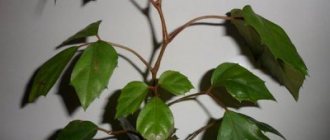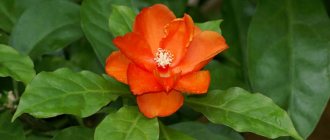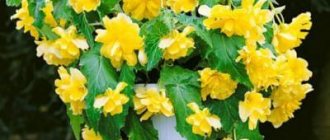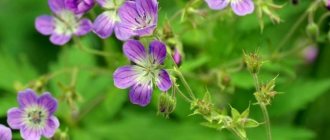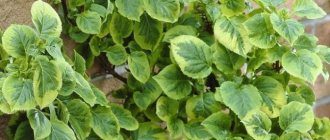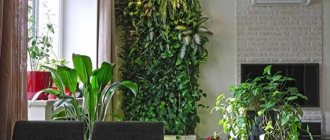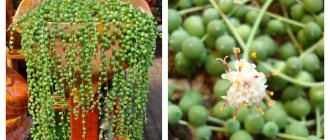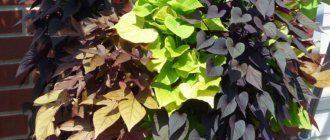Botanical description of dyschidia
Belongs to the Lastovniev family and is part of the group of compact vines. Looks great in hanging baskets, like an ampel flower with cascades of lashes. Blooms colorful flowers 2-3 times a year.
Dyschidia has two types of leaf blades:
- Some are flat, elongated and round in shape. They sit on shortened roots, rarely arranged in pairs along the vine. The symmetrical, not dense planting adds pattern and ornamentation. They are painted in light green shades, which makes them look unusually fresh. The tops and bases are pointed;
- Others look like bubbles with an internal cavity where water accumulates. The shape is similar to a jug, bag or coconut. They grow up to 5 cm in length. The color of the upper plate is similar to ordinary leaves, and the color below is reddish-brown.
Insects invade the space of the “bags”, make their way through the passages, and drag in plant particles. Thanks to special conditions and humidity, rotting begins and a nutrient substrate is formed. Aerial roots grow from within and receive the necessary water from their own reservoir.
The plant independently regulates its humidity level. Even during prolonged drought it can provide itself with moisture.
Types and varieties of dischidia
More than 120 plant species live in natural conditions. But there are only seven decorative ones among them. What varieties can you grow at home:
- Dischidia pectinata. It blooms twice a year with raspberry-pink or cherry flowers. On the creeping shoots there are many aerial roots and oval leaves of a soft green color;
- Dischidia Russifolia. The main advantage is the many graceful small leaves, shaped like hearts. For this feature, the flower received the characteristic name “million hearts”. During flowering, tiny snow-white flowers are born from the axils, fragrant with a delicate aroma;
- Dischidia ovata. The elongated long stems are colored greenish-pink. The leaves have a neat oval shape. Young leaves initially look pink, then acquire the traditional green color. Clear white veins are visible on the plates. An unpretentious and persistent plant. Tolerates minor cold snaps and drafts well;
- Dischidia vidalia. The stems and leaves are rich green in color. Flowering occurs 2-3 times a year. The flower petals are colored light pink;
- Dischidia hirsuta. A rare species with unusual leaves. The uniqueness lies in the dense pubescence and relief of the veins. During the flowering stage it bears many purple tiny flowers on short stalks;
- Dischidia raffles. The stems grow up to 5 m. The leaves are oblong, rather dense. Neat flowers are collected in umbrellas, the color is soft yellow;
- Apple leaf dischidia. The curly chiseled leaves resemble green apples. Quite dense and elastic. The stems are strong and rich in color.
Home care
Dischidia are easy to grow, but are still more suitable for experienced gardeners due to their special requirements for humidity and stability. Infrequent watering and fertilizing greatly simplifies care. At the slightest deviation from comfortable conditions, the leaves drop or wither.
Used to create elegant compositions:
- from shells with succulents;
- in glass flasks and mini-gardens;
- in decorative florariums with stones and shells;
- in paludariums or terrariums.
They are planted as hanging flowers in hanging containers in greenhouses and winter gardens. They need support in the form of bases or trellises made of wooden and steel materials.
Soil for planting
Select a substrate for bromeliad species or orchids. Requirements for the soil mixture:
- Air permeability;
- Moisture permeability;
- Looseness;
- Fibrous.
As an epiphyte, dischidia grows well on the bark of deciduous and coniferous trees, in containers with charcoal, fern rhizomes, and sphagnum.
Lighting
Loves bright places and additional artificial lighting. But it does not tolerate direct sunlight well; the best option is diffused light. Otherwise, burns on the leaves are possible.
Temperature
The flower is heat-loving and heat-tolerant. The best temperature is 25-30 degrees; at these temperatures, long-term flowering occurs. It is important to ensure that the lower threshold does not fall beyond 18 degrees in winter.
Humidity
Dischidia needs constant increased humidity, which will not fall below 45-50%. To do this, spray the leaves daily. You can use humidifiers. The container is placed on a pallet:
- with wet expanded clay;
- moistened with sand;
- moss
The bottom of the pot should not come into contact with water.
Watering
Water moderately as the top layer of soil dries completely to a depth of three centimeters. Use settled soft water at a temperature of 22-24 degrees.
Feeding
Use compositions for decorative foliage species or succulents. In order for dyschidia to feel good, there are 2 options for fertilizing:
- In April and July, only twice a year, diluted 1 to 2 with a mixture;
- Monthly in reduced dosages - throughout the spring and until the end of summer.
Dischidia growing from seeds
To propagate a plant by seed, you need to wait until, after flowering, pod-like fruits are formed, which have flying seeds that look like dandelions. You need to work with them carefully, as they are very small and easily lost.
Seeds should be sown in spring. For sowing, you need to use a soil mixture that includes sand and peat or sand and leaf turf in equal proportions. Seeds should not be distributed densely over the soil. It should be watered before the procedure. After sowing the seeds, you should sprinkle them with a small layer of peat on top, cover them with film and put them in a warm and well-lit place.
Every day the film must be removed and the seedlings ventilated. When the first shoots appear, the container with them should be shaded so that they are not exposed to direct sunlight. When a pair of leaf blades appears on young plants, they need to be picked to a permanent place of growth.
Transplanting an ampelous plant
It is carried out only in the spring, when active growth begins. Young dischidia, whose roots grow voluminously in pots, need to be replanted. A thickened layer of drainage is laid on the bottom.
Features of reproduction
To propagate dischidia, vegetative and seed methods are used. A faster option is to grow from cuttings, which are cut from the tops of young stems. The plant has many aerial roots, the material takes root quickly.
How to do it correctly:
- The cut is made obliquely, sprinkled with charcoal powder on top;
- The standard length of cuttings is 8-10 cm;
- Immerse in water for 2-3 days, which is replaced daily;
- Installed in the substrate at an angle;
- Cover with a cap;
- Keep warm at a temperature of 20-22 degrees;
- Ventilate.
For planting cuttings, a sand-peat mixture is selected.
Inside the bags you can almost always find daughter shoots with roots, ready for separation. The leaves are carefully cut, new vines are disconnected and transplanted into a container.
For seeds, use the same light, moist substrate with peat impurities. The seeds are slightly buried by 0.5-1 cm, sprinkled on top with a thin layer and compacted. The containers are kept under film or glass, as in a greenhouse, until shoots appear. Maintain temperature 20-25 degrees, humidity 50-60%.
Botanical characteristics
Dischidia belongs to a large genus in the Lastovnieceae family. The liana has many thread-like roots, which are located at the base of the bush, and also cover the side shoots. The root system serves for anchorage and also for obtaining nutrients from the air. The shoots are highly flexible and green in color. Under natural conditions, they can reach a length of 5 m.
Dischidia grows two types of leaves. The first ones are flat, have a round or elongated shape. They are attached to short petioles and densely cover the stems along the entire length. The latter are a kind of storehouse; they resemble a coconut or a jug in shape and reach a length of 5 cm. The leaves are a thick, oblong bubble with a cavity inside. Insects often make passages into the interior space and collect various plant debris. Under the influence of moisture, the accumulations begin to rot and form nutritious soil. Over time, aerial roots grow inside the bubble and the plant gains access to humus in its own bins.
Dyschidia blooms several times a year. It is covered with small axillary flowers in the shape of bells. The petals come in red, pink and white. The buds are grouped into small whorls of 2-4 pieces.
After the flowers fade, small pods containing seeds are formed. Each seed has a tiny umbrella, similar to a dandelion.
Types of dyschidia
More than 120 varieties of dyschidia are found naturally, but only a few of them are used in culture. All of them are suitable for indoor growing, although they require a lot of attention.
Dischidia ovata. The plant has long green-pinkish stems covered with oval leaves. Young leaves are pink at first but gradually turn light green. Whitish veins are visible on the leaves, which increase the decorative appearance of the plant. This species tolerates drafts and slight cold snaps normally.
Dischidia ruscusolifolia (Rusifolia). A very graceful form with long stems densely covered with heart-shaped small leaves. For this appearance, flower growers often call it “dischidia of a million hearts.” During the flowering period, small snow-white flowers appear in the axils of the leaves. Flowering is accompanied by an intense honey aroma.
Dischidia pectinata. The creeping stems are densely covered with aerial roots and oval leaves. The shoots are colored light green. Twice a year the liana blooms with small pink or cherry flowers.
Dischidia vidalia. The variety has a bright green color and many rounded leaves. Light pink flowers appear 2-3 times a year.
Dischidia hirsuta. Quite a rare variety with rounded, densely pubescent foliage. Relief veins are visible on each leaf. During the flowering period, a large number of small purple flowers are formed on short peduncles.
Dischidia raffles. The plant grows long (up to 5 m) shoots covered with oblong, dense leaves. It blooms with small yellowish flowers, which are collected in small umbrellas.
Apple leaf dischidia. It has more elastic stems and large foliage. Each leaf is shaped like an apple and is green with white spots.
Diseases
The plant may have problems with leaves and shoots, which indicates non-compliance with the growing conditions:
- due to low air humidity, the disappearance of leaf bubbles or deformation of the leaves, which become excessively small, and the tendrils may darken, are possible;
- Direct sunlight causes the leaves to turn red.
If dischidia is watered too often and abundantly, the roots and shoots begin to rot. Active pests include mealybugs, aphids and spider mites. Therefore, growing conditions should be adjusted, and if necessary, treat the flower with insecticides.
Reproduction methods
Dischidia is propagated by sowing seeds or cuttings. Since it forms many aerial roots, the rooting process is very easy. It is enough to cut off the apical shoot about 10 cm long and root it. You can first put the cuttings in boiled water for several days. The fluid is changed daily. It is allowed to immediately plant the shoot into the soil. For planting, use a moist sand-peat substrate.
The plant needs a warm room, not lower than +20°C, as well as high humidity. During the first month, you can cover the shoot with a bottle or film, but be sure to ventilate it daily. If there is a mature bladder leaf next to the cutting, it may contain a root ready to be planted. You need to cut the leaf and transplant the shoot into a separate container.
When dischidia is propagated by seeds, a moist mixture of peat and sand is used, into which the seeds are buried. The container is covered with film or glass and left in a bright and warm room. Shoots will begin to appear within a week, but plants are transplanted from the greenhouse only after 3 months. Young seedlings are carefully watered and the duration of ventilation is increased daily. The grown sprouts are carefully replanted without picking along with a lump of earth. Any damage to the root system can lead to the death of the plant.
Rules of care
Dischidia is considered a rather demanding flower and not every gardener manages to grow a large plant. In fact, she doesn’t need much attention; it’s enough to choose the right habitat. Dischidia prefers sunny and warm places with high humidity. It is better not to place it on the balcony if the air becomes much colder at night. Liana feels great in rooms with eastern or western windows.
The optimal air temperature is +25…+30°C. When flowering ends, you need to provide the dischidia with a period of rest and move it to a cooler room (+18...+22°C).
For planting, use a light substrate for epiphytes. You can make up the required mixture yourself from the following components:
- sphagnum moss;
- charcoal;
- crushed pine bark;
- sand;
- leaf soil;
- perlite;
- peat or fern rhizomes.
Excess moisture is detrimental to the root system of dyschidia. It is important to completely dry the substrate between waterings. Even in hot summer, it is enough to water the plant 2 times a month. In winter, the soil is watered monthly with small portions of liquid. You can combine the watering procedure with bathing. The pot is transferred to the bathroom and watered with low pressure of warm water. It is important to completely drain the excess liquid.
High humidity is of great importance. If the air in the room is dry, place cups of water or wet expanded clay next to the plant. Some gardeners, if there is a window in the bathroom, place the plant in this room.
During the period of active growth, dischidia is fertilized monthly with a composition for succulents. It is enough to apply only half the serving indicated on the label.
Lush greens attract aphids, mealybugs and spider mites. Parasites can quickly destroy even an adult plant, so you should immediately treat them with insecticides (Vermitec, Sunmite, Akarin, Arrivo, Fitoverm).
Diseases and pests
Among the diseases, the plant is susceptible to root rot, which develops when the soil becomes waterlogged as a result of improper watering. Root rot leads to the withering of the crop and its death. You can save a diseased plant by replanting it in a fresh substrate and a new pot with preliminary pruning of the affected roots and treating them with a solution of potassium permanganate.
Dyschidia can also be attacked by pests such as mealybugs and spider mites. To destroy them, the plant must be treated with the Actellik insecticide according to the instructions on the package with the drug.
Types of Dischidia plants and proper care for them
Despite the popularity and variety of indoor vines, a plant such as dischidia is a rarity in the home collections of amateur gardeners.
Although dyschidia does not have excessive care requirements, if not maintained correctly it dies quite quickly. Therefore, it is believed that only experienced gardeners can grow this exotic plant.
Secrets of success
Dischidia is a slow growing plant, but for its full development it is necessary to provide good lighting. The ideal location is south-facing windows, with obligatory shading from direct sunlight.
Since Dischidia is also a heat-loving plant, for its normal development it is necessary to maintain a sufficiently high temperature. Optimal indicators are +20-25°C. In winter, during the dormant period, the temperature can be reduced to +18°C.
Watering also depends on the time of year. In summer it should be plentiful, but without waterlogging, in winter it should be moderate. It is recommended to maintain humidity at a high level for Dischidia. Daily spraying will provide the necessary conditions of detention.
What kind of plant is this?
Dischidia is a plant belonging to the Lastovnevy family. Its habitat is tropical forests in Australia, India and Polynesia. There are about 120 varieties of dyschidia in nature , but only a few of them are suitable for home cultivation.
Dischidia is a spreading vine with thin and flexible green shoots up to 5 meters long. These shoots have a large number of whitish roots that are firmly attached to other plants. Being a parasitic plant, dischidia can suck out the juices of plants that it entwines.
Dischidia has two types of leaves:
- flat light green leaves of a round or elongated shape, completely covering the entire stem;
- dense leaves about 5 cm long, similar in appearance to a coconut or a pitcher. By merging with each other, these leaves form cavities in which moisture is stored.
Dischidia usually blooms 2 times a year. Its flowers, reminiscent of bells in shape, come in red, white or pink shades and are collected in inflorescences of 2-4 pieces.
After flowering ends, small seed pods are formed, each of which has a miniature umbrella, similar to a dandelion.
Possible difficulties
Leaves wrinkle and dry out
Reasons: 1) low humidity, 2) low temperature.
Leaves become pale and lose color
Reasons: 1) insufficient lighting.
Subscribe and receive descriptions of new species and varieties in the “succulents” section by email!
Dischidia belongs to the family of epiphytes Lastovniev. The habitat of this plant in the wild is the tropical forests of India, as well as Australia and Polynesia. Dischidia attaches with aerial roots to the trunks and branches of another plant, entwines it and thus attaches itself quite firmly. To grow dischidia indoors, use the ampel method.
To grow it, you need a reliable support to which it will cling with its aerial roots and grow like a vine. This plant is interesting because it has two different types of leaves. The first ones are oval, thin, light green in color; the latter are dense, fleshy, can grow together and form something like a container for collecting and storing water.
Under natural conditions, such water lilies can be inhabited by ants and other insects. Dischidia can feed from the axils of leaves with water, launching part of the aerial roots into them. Dischidia can bloom 3-4 times a year with small white, red or pink flowers. The peduncle has three flowers and grows from the leaf axil.
Types and description with photos
Grebeshkovaya
Dischidia Pectenoides is a liana with creeping stems, on the surface of which there are aerial root shoots. It has two types of leaves: the main leaves are grassy green in color and additional bubble-shaped ones, the outer side of which is painted in a rich green color, and the inner side is painted brick. The flowers of this variety are cherry or pink in color.
Home care
It is believed that not every gardener will be able to grow such a demanding and specific plant as dischidia. In fact, it is enough just to choose the right location and constantly maintain high air humidity. In addition, dischidia does not need frequent watering and fertilizers, which greatly simplifies its care.
Important! It is also necessary to remember about the timely removal of dried leaves and twigs and trim the overgrown shoots of the plant.
At home, dischidia can be grown in 2 options:
- as an ampelous plant in hanging pots;
- as a vine on trellises or decorative bases.
Placement and lighting
Dischidia should be placed in a bright place, as it is very light-loving. But we should not forget about the high sensitivity of the plant to direct sunlight, which should be avoided. It is better if the lighting for dyschidia is diffused.
The most suitable place to place it is near the windows on the western or eastern side, where there is sufficiently good lighting.
Dischidia also grows well in artificial light, so it can be successfully grown in humid florariums, paludariums or flower displays.
Landing
For planting dischidia, special substrates for bromeliad plants are used, which have good water and air permeability.
You can prepare your own mixture for the plant by mixing charcoal, sand, peat soil, sphagnum moss, perlite, and leaf soil. Since dischidia is an epiphytic plant , it will feel comfortable on the bark of trees, to which it can be tied with wire, or in special blocks, on the bottom of which a mixture of pine bark and charcoal is laid out. The roots of the plant can also be covered with sphagnum moss.
Transfer
A young plant needs replanting once a year , an adult - once every 2-3 years or as needed, when the roots of the plant fill the entire pot. At the bottom of the container where the plant is transplanted, you need to lay out a drainage layer consisting of expanded clay, broken bricks and pebbles.
Watering
You should not water dyschidia too often. In spring and summer, watering should be done approximately once every 2 weeks, as the top 2-3 cm layer of soil dries. In autumn and winter, watering is reduced to once a month.
Important! In addition to watering, you can wash the dischidia with a low pressure of warm water, not forgetting to drain the excess liquid, since the dischidia does not like waterlogged soil.
Water for irrigation should be soft (filtered or boiled), room temperature and free of unnecessary impurities.
Temperature
The optimal temperature for growing dischidia should be from 25 to 30 degrees Celsius. After flowering is completed, during the plant's dormant period, the temperature should be lowered to 18-22 degrees.
Content
- General information
- Dischidia species and varieties
- Dyschidia care at home
- Watering dischidia
- Soil for dyschidia
- Fertilizer for dyschidia
- Dischidia bloom
- Pruning dyschidia
- Dyschidia transplant
- Caring for dyschidia during the dormant period
- Dischidia growing from seeds
- Propagation of dyschidia by cuttings
- Diseases and pests
- Conclusion
